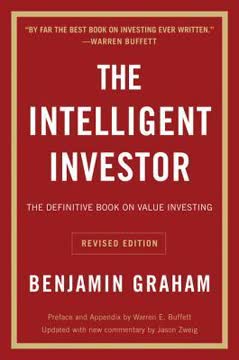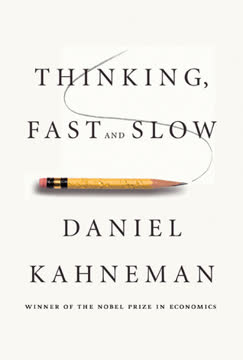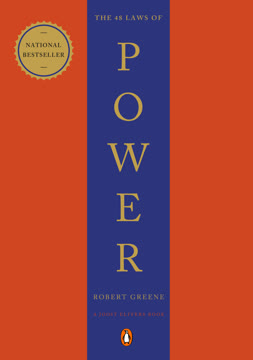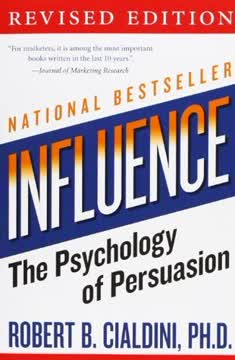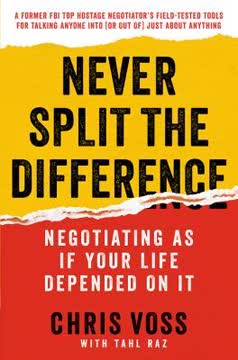ข้อสำคัญ
1. การเจรจาคือการรวบรวมข้อมูลและการชักจูงพฤติกรรม
Voss นิยามการเจรจาว่าเป็น “การรวบรวมข้อมูลและการชักจูงพฤติกรรม”
นิยามใหม่ของการเจรจา Voss ขยายความหมายของการเจรจาให้กว้างกว่าการเจรจาธุรกิจอย่างเป็นทางการ โดยชี้ให้เห็นว่าการเจรจาครอบคลุมแทบทุกการปฏิสัมพันธ์ระหว่างผู้คน มุมมองนี้เปลี่ยนการเจรจาจากกิจกรรมที่มีลักษณะเผชิญหน้าเป็นกระบวนการร่วมมือเพื่อความเข้าใจและการชักจูงซึ่งกันและกัน
การก้าวข้ามอุปสรรคส่วนตัว ขั้นตอนแรกในการเชี่ยวชาญการเจรจาคือการเอาชนะความกลัวและความไม่ชอบการเจรจา ด้วยการตระหนักว่าการเจรจาเป็นส่วนหนึ่งของปฏิสัมพันธ์มนุษย์พื้นฐาน บุคคลจึงสามารถเผชิญหน้ากับมันด้วยความมั่นใจและลดความวิตกกังวลลงได้
การประยุกต์ใช้ในชีวิตจริง:
- การพูดคุยเรื่องเงินเดือน
- การตัดสินใจซื้อของ เช่น บ้าน รถยนต์
- การแก้ไขข้อขัดแย้งในความสัมพันธ์ส่วนตัว
- การสื่อสารในชีวิตประจำวันกับเพื่อนร่วมงาน เพื่อน และครอบครัว
2. การฟังอย่างแท้จริงคือกระบวนการที่ต้องมีส่วนร่วมอย่างเต็มที่ ไม่ใช่แค่ฟังผ่าน ๆ
การฟังคือหนึ่งในกิจกรรมที่ต้องใช้ความตั้งใจมากที่สุดของมนุษย์
การมีส่วนร่วมอย่างกระตือรือร้น Voss เน้นว่าการฟังอย่างมีประสิทธิภาพต้องใช้ความตั้งใจและการมีส่วนร่วมอย่างเต็มที่ ไม่ใช่แค่ได้ยินคำพูด แต่ต้องประมวลผลและตอบสนองต่อข้อมูลที่ได้รับอย่างจริงจัง
ข้อผิดพลาดที่พบบ่อย หลายคนมักจะจดจ่อกับการเตรียมโต้แย้งหรือแสดงความเห็นของตนเองในระหว่างการเจรจา ซึ่งเป็นอุปสรรคต่อการฟังอย่างแท้จริงและทำให้ไม่เข้าใจความต้องการหรือแรงจูงใจของอีกฝ่าย
กุญแจสู่การฟังอย่างกระตือรือร้น:
- มุ่งความสนใจไปที่ผู้พูดโดยไม่เตรียมคำตอบในใจล่วงหน้า
- สังเกตสัญญาณที่ไม่ใช่คำพูดและน้ำเสียงที่แฝงอารมณ์
- ถามคำถามเพื่อความชัดเจนและความเข้าใจ
- แสดงความตั้งใจฟังผ่านภาษากายและคำพูดตอบรับ
3. ความเห็นอกเห็นใจเชิงกลยุทธ์: กุญแจสู่การสร้างความไว้วางใจและความสัมพันธ์
Voss กล่าวว่าแทนที่จะแยกคนออกจากอารมณ์ วิธีที่ดีกว่าคือการตั้งชื่อให้อารมณ์นั้น
เกินกว่าความเห็นอกเห็นใจแบบเดิม ความเห็นอกเห็นใจเชิงกลยุทธ์ไม่ได้หมายถึงแค่เข้าใจอารมณ์ แต่เป็นการใช้ความเข้าใจนั้นอย่างมีชั้นเชิงเพื่อชักจูงการเจรจา เป็นการปรับตัวให้สอดคล้องกับสภาวะอารมณ์ของอีกฝ่ายเพื่อสร้างความไว้วางใจและความสัมพันธ์ที่ดี
การสั่นสะเทือนของสมอง Voss อธิบายถึงการสังเกตอย่างใกล้ชิดทั้งสีหน้า การกระทำ และน้ำเสียง จากนั้นปรับตัวให้สอดคล้องกับสัญญาณเหล่านี้ ซึ่งจะสร้างความรู้สึกเชื่อมโยงและความเข้าใจระหว่างกัน
การนำความเห็นอกเห็นใจเชิงกลยุทธ์ไปใช้:
- สังเกตและระบุสัญญาณอารมณ์
- พูดออกมาเพื่อแสดงความเข้าใจในอารมณ์นั้น
- ใช้ความเข้าใจนี้นำทางการสนทนา
- รักษาท่าทีสงบและเคารพตลอดเวลา
4. การตั้งชื่ออารมณ์ช่วยคลายความตึงเครียดและส่งเสริมการคิดอย่างมีเหตุผล
เมื่ออารมณ์ถูกตั้งชื่อ ความคิดของคนจะมีเหตุผลและกลัวน้อยลง
พลังของการยอมรับ การตั้งชื่ออารมณ์เป็นการยืนยันความรู้สึกของอีกฝ่าย ทำให้เขารู้สึกว่าได้รับการเข้าใจ ซึ่งช่วยลดความตึงเครียดและความรู้สึกป้องกันตัวลงได้อย่างมาก
ส่งเสริมการคิดที่ชัดเจน การช่วยให้คนระบุและประมวลผลอารมณ์ของตนเองทำให้การตัดสินใจมีเหตุผลมากขึ้นและไม่ถูกครอบงำด้วยอารมณ์
วิธีตั้งชื่ออารมณ์อย่างมีประสิทธิภาพ:
- ใช้ประโยคเช่น “ดูเหมือนว่า...” หรือ “ฟังดูเหมือนว่า...”
- เน้นที่อารมณ์ ไม่ใช่ตัวบุคคล
- ปล่อยให้มีช่วงเวลานิ่งหลังตั้งชื่อเพื่อให้อีกฝ่ายได้ประมวลผล
- พร้อมปรับเปลี่ยนหากการตั้งชื่อครั้งแรกไม่ถูกต้อง
5. คำว่า “ไม่” มีพลัง: ยอมรับมันเป็นจุดเริ่มต้น
ตามที่ Voss กล่าว “ไม่” ไม่ใช่สัญญาณของการปฏิเสธ แล้วคำว่า “ไม่” อาจหมายความว่าอย่างอื่นได้ไหม?
เปลี่ยนมุมมองเรื่องการปฏิเสธ Voss ท้าทายความคิดเดิมที่มองคำว่า “ไม่” เป็นทางตัน แต่กลับมองว่าเป็นจุดเริ่มต้นของการพูดคุยและเจรจาที่ลึกซึ้งขึ้น
ความหมายหลากหลายของ “ไม่” คำว่า “ไม่” อาจหมายถึง:
- ต้องการข้อมูลเพิ่มเติม
- ต้องการความชัดเจน
- ปกป้องจุดยืนปัจจุบัน
- แสดงความเป็นอิสระ
- ขอเงื่อนไขที่แตกต่างออกไป
การใช้ “ไม่” ให้เกิดประโยชน์:
- ใช้เพื่อค้นหาความกังวลหรือข้อคัดค้านที่ซ่อนอยู่
- มองเป็นโอกาสในการปรับปรุงข้อเสนอ
- ส่งเสริมการสื่อสารอย่างตรงไปตรงมา
6. ระวังคำว่า “ใช่”: แยกแยะระหว่างการยอมรับจริง การยืนยัน และการยอมรับปลอม
คำว่า “ใช่” มีสามประเภท อะไรบ้าง? แยกแยะให้ชัดเจน
ประเภทของ “ใช่”:
- การยอมรับจริง: การตกลงอย่างแท้จริงที่จะดำเนินการตามนั้น
- การยืนยัน: การรับรู้ข้อเท็จจริงหรือคำกล่าว
- การยอมรับปลอม: การตอบตกลงเพื่อหลีกเลี่ยงความขัดแย้งหรือจบการสนทนา
อันตรายของการยอมรับอย่างรวดเร็ว การรีบเร่งให้ได้คำว่า “ใช่” อาจนำไปสู่ข้อตกลงผิวเผินที่ไม่แก้ไขปัญหาหรือข้อกังวลที่แท้จริง
กลยุทธ์เพื่อการยอมรับที่แท้จริง:
- ขอความชัดเจนว่าคำว่า “ใช่” หมายถึงอะไร
- สังเกตสัญญาณทางวาจาและไม่ใช่คำพูดที่สอดคล้องกัน
- ติดตามผลด้วยขั้นตอนหรือความมุ่งมั่นที่ชัดเจน
- อดทนและพร้อมสำรวจข้อกังวลที่ซ่อนอยู่
7. คำถามที่ปรับแต่งได้สร้างภาพลวงตาของการควบคุม
Voss กล่าวว่า การเจรจาที่ประสบความสำเร็จทำให้อีกฝ่ายรู้สึกว่าตนเองมีอำนาจควบคุม
พลังของการค้นพบที่มีการชี้นำ คำถามที่ปรับแต่งได้จะนำพาอีกฝ่ายไปสู่ผลลัพธ์ที่ต้องการในขณะที่ทำให้เขารู้สึกว่าตนเองเป็นผู้ควบคุม วิธีนี้ช่วยลดความต้านทานและเพิ่มความร่วมมือ
ลักษณะของคำถามที่ปรับแต่งได้อย่างมีประสิทธิภาพ:
- เป็นคำถามปลายเปิด (ไม่ตอบได้แค่ใช่หรือไม่ใช่)
- เริ่มต้นด้วยคำว่า “อะไร” หรือ “อย่างไร”
- กระตุ้นให้อีกฝ่ายแก้ปัญหา
- หลีกเลี่ยงน้ำเสียงที่กล่าวหา หรือเผชิญหน้า
ตัวอย่างคำถามที่ปรับแต่งได้:
- “เราจะแก้ปัญหานี้อย่างไรดี?”
- “ความท้าทายที่ใหญ่ที่สุดที่คุณเผชิญคืออะไร?”
- “คุณอยากให้ผมดำเนินการอย่างไร?”
8. กฎ 7-38-55: การสื่อสารที่ไม่ใช่คำพูดมีบทบาทมากที่สุด
กฎ 7-38-55 คืออะไร? ทำไมจึงสำคัญในการเจรจา?
การแบ่งสัดส่วนของการสื่อสาร:
- 7% ของข้อความ: คำพูดที่ใช้
- 38% ของข้อความ: น้ำเสียง
- 55% ของข้อความ: ภาษากายและสีหน้า
ความสำคัญในการเจรจา การเข้าใจกฎนี้ช่วยให้ผู้เจรจาให้ความสำคัญกับมากกว่าคำพูดที่ได้ยิน โดยเน้นการสังเกตน้ำเสียงและภาษากายทั้งของตนเองและอีกฝ่าย
การนำกฎ 7-38-55 ไปใช้:
- รักษาความตระหนักรู้ในสัญญาณที่ไม่ใช่คำพูดของตนเอง
- สังเกตความไม่สอดคล้องระหว่างคำพูดกับสัญญาณไม่ใช่คำพูด
- ใช้เทคนิคการสะท้อนเพื่อสร้างความสัมพันธ์
- ฝึกฟังอย่างตั้งใจโดยใช้ประสาทสัมผัสทุกด้าน
9. อย่าแบ่งความต่าง: มุ่งหาทางออกที่สร้างสรรค์
ทำไม Voss ถึงไม่สนับสนุนแนวทาง “win-win”?
เกินกว่าการประนีประนอม Voss เห็นว่าการแบ่งความต่างมักนำไปสู่ผลลัพธ์ที่ไม่เต็มที่สำหรับทั้งสองฝ่าย เขาจึงสนับสนุนการหาทางออกที่สร้างสรรค์ซึ่งตอบสนองความต้องการหลักของทุกฝ่าย
ข้อเสียของแนวคิด “win-win”:
- อาจทำให้แก้ปัญหาแบบผิวเผิน
- อาจมองข้ามแรงจูงใจและความต้องการที่แท้จริง
- มักทำให้ไม่มีฝ่ายใดพึงพอใจอย่างเต็มที่
กลยุทธ์สำหรับการแก้ปัญหาอย่างสร้างสรรค์:
- เจาะลึกเพื่อเข้าใจแรงจูงใจและความต้องการที่แท้จริง
- สำรวจทางเลือกหลาย ๆ ทางก่อนตัดสินใจ
- พร้อมที่จะถอยหากไม่พบทางออกที่เป็นประโยชน์จริง ๆ
- มุ่งเน้นความสัมพันธ์ระยะยาวมากกว่าผลประโยชน์ระยะสั้น
10. การเจรจาเป็นทักษะที่ใช้ได้ในทุกด้านของชีวิต
Christopher Morrison จาก Topher Communications แนะนำให้ผู้เชี่ยวชาญด้านการขายอ่านหนังสือของ Voss โดยเขากล่าวว่านี่อาจเป็น “หนังสือโปรดในอาชีพของพวกเขา”
การประยุกต์ใช้ที่ครอบคลุม แม้ว่า Voss จะมีพื้นฐานจากการเจรจาในสถานการณ์จับตัวประกันที่มีเดิมพันสูง แต่หลักการที่เขาสอนนั้นมีคุณค่าในชีวิตประจำวันและในหลากหลายอาชีพ
ประโยชน์ที่เกินกว่าธุรกิจ ทักษะการเจรจาช่วยพัฒนา:
- ความสัมพันธ์ส่วนตัว
- การแก้ไขข้อขัดแย้ง
- กระบวนการตัดสินใจ
- ประสิทธิภาพในการสื่อสาร
- ความสามารถในการแก้ปัญหา
อาชีพที่ได้รับประโยชน์จากทักษะการเจรจา:
- ฝ่ายขายและการตลาด
- การบริหารและผู้นำ
- กฎหมายและการทูต
- การดูแลสุขภาพและงานสังคมสงเคราะห์
- การศึกษาและการให้คำปรึกษา
อัปเดตล่าสุด:
FAQ
What's "Never Split the Difference" about?
- Practical Guide to Negotiation: "Never Split the Difference" by Chris Voss is a practical guide on negotiation, drawing from Voss's experience as an FBI hostage negotiator.
- High-Stakes Situations: The book shares tactics used in high-stakes situations, applicable to both personal and professional negotiations.
- Everyday Negotiations: It emphasizes that negotiation is a part of everyday life, from buying a home to negotiating salaries.
- Emotional Intelligence: Voss highlights the importance of emotional intelligence and intuition in successful negotiations.
Why should I read "Never Split the Difference"?
- Real-World Applications: The book provides strategies that can be applied in various real-world scenarios, enhancing both personal and professional interactions.
- Expert Insights: Learn from Chris Voss, a former FBI hostage negotiator, who shares proven techniques from his extensive experience.
- Improved Communication: It offers insights into improving communication skills, crucial for effective negotiation.
- Empathy and Influence: The book teaches how to use empathy and influence to achieve desired outcomes in negotiations.
What are the key takeaways of "Never Split the Difference"?
- Negotiation as Information Gathering: Voss defines negotiation as "information-gathering and behavior-influencing," applicable to any interaction.
- True Listening: Emphasizes the importance of active listening to understand and influence the other party.
- Tactical Empathy: Introduces the concept of tactical empathy, which involves understanding and influencing emotions.
- Labeling Emotions: Highlights the technique of labeling emotions to make negotiations more effective.
What is the fundamental definition of negotiation according to Chris Voss?
- Information Gathering: Voss defines negotiation as a process of gathering information and influencing behavior.
- Everyday Interactions: It encompasses almost any interaction where one person wants something from another.
- Overcoming Fears: Mastery begins with overcoming personal fears and aversions to negotiation.
- Influencing Perceptions: Effective negotiation involves influencing the other person's perception to achieve desired outcomes.
What is tactical empathy in "Never Split the Difference"?
- Beyond Empathy: Tactical empathy goes beyond understanding feelings; it involves reading what's behind those feelings.
- Influence Through Empathy: It increases influence by aligning with the other person's emotions and expressions.
- Neural Resonance: Voss describes it as creating a connection through understanding and validating emotions.
- Building Trust: Tactical empathy helps build trust, crucial for successful negotiations.
How does Chris Voss suggest handling emotions in negotiations?
- Labeling Emotions: Voss advises labeling emotions rather than separating them from the person.
- Empathy Over Sympathy: Emphasizes empathy, which involves recognizing and vocalizing the other person's feelings.
- Calming Effect: Labeling emotions helps calm the person, making them more rational and less fearful.
- Uncovering Primary Emotions: It helps uncover the primary emotions driving behavior, facilitating better negotiation outcomes.
What are the benefits of labeling emotions in negotiations?
- Rational Thinking: Labeling emotions helps the counterpart think more rationally and less fearfully.
- Faster Resolution: It speeds up the process of addressing fears, preventing them from overwhelming the person.
- Trust Building: Validating emotions builds trust, essential for effective communication and negotiation.
- Understanding Motivations: Helps uncover the primary emotions driving the person's behavior, leading to more productive negotiations.
What are the two levels of emotions in negotiations according to Chris Voss?
- Presenting Behavior: The visible actions and reactions during a negotiation.
- Underlying Feelings: The emotions that motivate the presenting behavior, which need to be addressed for effective negotiation.
What does Chris Voss mean by "Yes" can be meaningless in negotiations?
- Three Types of "Yes": Voss identifies counterfeit, confirmation, and commitment as the three types of "Yes."
- Hidden Objections: A "Yes" can hide deeper objections and may not indicate genuine agreement.
- Beware of "Yes": Negotiators should be cautious of "Yes" as it might not reflect true commitment.
- Focus on "No": Voss suggests mastering "No" as it can lead to more honest and productive discussions.
Why does Chris Voss advocate against a "win-win" approach?
- Illusion of Compromise: Voss argues that splitting the difference often leads to suboptimal outcomes.
- Non-Linear Process: Negotiation is not a linear formula; it requires flexibility and adaptation.
- True Resolution: A successful negotiation should address the underlying needs and emotions, not just reach a compromise.
- Control Illusion: Effective negotiation involves making the counterpart feel they are in control, leading to better solutions.
What is the 7-38-55 rule in negotiations?
- Communication Breakdown: The rule states that 7% of communication is words, 38% is tone, and 55% is body language.
- Importance of Non-Verbal Cues: Highlights the significance of non-verbal and paraverbal communication in negotiations.
- Building Rapport: Understanding this rule helps negotiators build rapport and trust with their counterparts.
- Effective Communication: Emphasizes the need to be conscious of all aspects of communication for successful negotiation.
How do empathy-based techniques work according to Chris Voss?
- Building Trust: Empathy-based techniques build trust by validating the other person's emotions.
- Understanding Motivations: They help understand the underlying motivations and emotions driving behavior.
- Influence and Control: By aligning with the counterpart's emotions, negotiators can influence outcomes more effectively.
- More Effective: These techniques are often more effective than traditional methods, leading to better negotiation results.
รีวิว
หนังสือเล่มนี้ได้รับคำชื่นชมอย่างกว้างขวาง โดยผู้อ่านส่วนใหญ่ยกย่องเทคนิคการเจรจาต่อรองที่ใช้งานได้จริง พร้อมตัวอย่างจากสถานการณ์จริงที่ช่วยให้เข้าใจง่าย หลายคนเห็นว่าเนื้อหาในหนังสือมีประโยชน์และนำไปปรับใช้ได้ในหลายบริบท ทั้งในธุรกิจและชีวิตประจำวัน อย่างไรก็ตาม บางเสียงวิจารณ์ว่าเทคนิคบางอย่างอาจดูเหมือนการชักจูงหรือเหมาะกับวัฒนธรรมเฉพาะกลุ่ม หนังสือเล่มนี้เน้นย้ำถึงความสำคัญของการเข้าใจความรู้สึกผู้อื่น การฟังอย่างตั้งใจ และการมองโลกจากมุมมองของอีกฝ่าย ซึ่งได้รับการยอมรับอย่างกว้างขวาง แม้ว่าจะมีผู้อ่านบางส่วนรู้สึกว่าเนื้อหาซ้ำซากหรือเน้นโปรโมตตัวเองเกินไป แต่โดยรวมแล้ว หนังสือเล่มนี้ถือเป็นแหล่งความรู้ที่มีคุณค่าสำหรับการพัฒนาทักษะการเจรจาต่อรองอย่างแท้จริง
Similar Books

